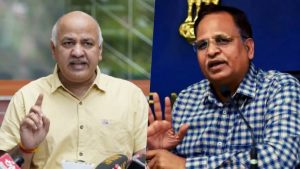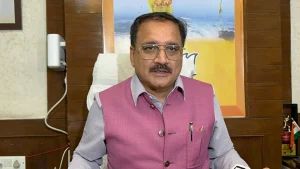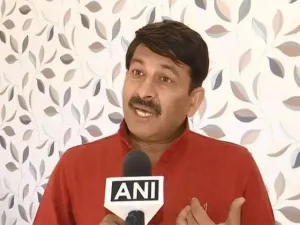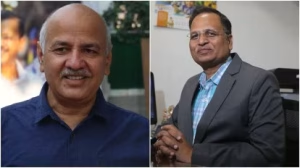New Delhi – The Anti-Corruption Branch (ACB) has intensified its scrutiny of the Aam Aadmi Party (AAP) with a significant development in the Delhi classroom corruption case. On Wednesday, the agency registered a First Information Report (FIR) against former Delhi Ministers Manish Sisodia and Satyendar Jain over alleged misappropriation of funds amounting to a staggering ₹2,000 crore in the construction of 12,748 classrooms across Delhi government schools during Arvind Kejriwal’s tenure as Chief Minister.
This Delhi classroom corruption case marks the second major corruption allegation against Jain in recent weeks, following another FIR filed approximately a month ago concerning a separate “₹571-crore CCTV project scam.” The mounting legal challenges against key AAP leaders have sparked intense political reactions across the capital’s political landscape.
Allegations of Inflated Costs in Delhi Classroom Corruption Case

At the heart of the Delhi classroom corruption case are accusations of drastically inflated construction costs. According to ACB officials, each classroom in the project cost an average of ₹28 lakh—a figure that investigators claim is several times higher than standard construction rates for similar facilities.
Also Read: Big L-G vs Govt. Tussle Ends in Delhi After 7 Years of Legal & Political Rivalry
Joint Commissioner of Police Madhur Verma, who heads the ACB, revealed that the Delhi classroom corruption case investigation drew significantly from a February 2020 report by the Central Vigilance Commission’s Chief Technical Examiner. “Several anomalies in the classroom construction project were pointed out in the report. But these findings were kept under wraps until now,” Verma stated during the official announcement of the FIR.
The Delhi classroom corruption case specifically targets Sisodia, who served as Delhi Education Minister, and Jain, who held the Public Works Department portfolio in the previous AAP government. Both are accused of awarding lucrative contracts to entities allegedly connected to AAP, raising serious questions about potential conflicts of interest and favoritism in the bidding process.
Political Fallout from the Delhi Classroom Corruption Case
The Delhi classroom corruption case has predictably triggered a political storm in the capital. Delhi BJP president Virendra Sachdeva characterized the development as a “decisive moment in the fight against corruption,” suggesting that the allegations validate long-standing criticisms from the opposition regarding financial impropriety within the AAP government.


Adding to the chorus of condemnation in the Delhi classroom corruption case, Delhi Congress chief Devender Yadav demanded punitive action, asserting that “those who looted the taxpayer must be given strict punishment.” The united front presented by traditionally opposing political forces underscores the gravity of the allegations and their potential impact on AAP’s political standing.
The AAP leadership has vehemently denied any wrongdoing in the Delhi classroom corruption case, dismissing the allegations as “absurd” and part of a larger pattern of persecution. Party spokespersons have accused the Delhi government, to which the ACB reports following recent administrative changes, of “filing baseless cases” against its leaders to undermine their political legitimacy and distract from governance issues.
Historical Context of the Delhi Classroom Corruption Case


The origins of the Delhi classroom corruption case can be traced back to 2019, when BJP’s North East Delhi MP Manoj Tiwari filed a formal complaint alleging financial irregularities in the classroom construction initiative. This initial complaint triggered preliminary inquiries that eventually culminated in the current investigation and subsequent FIR.
The Delhi classroom corruption case centers on a flagship education infrastructure project that was previously showcased by the AAP government as evidence of its commitment to improving educational facilities in the capital. Between 2015 and 2019, the Delhi government undertook an ambitious plan to construct additional classrooms across government schools to address overcrowding and enhance learning environments.
What began as a celebrated initiative has now become the focal point of the Delhi classroom corruption case, with investigators alleging that the noble objective of educational improvement served as cover for substantial financial malfeasance. The Central Vigilance Commission’s report, now central to the investigation, reportedly identified numerous procedural violations, cost irregularities, and quality control failures that collectively point toward systemic corruption.

Technical Aspects Under Scrutiny in Delhi Classroom Corruption Case
Experts involved in analyzing the Delhi classroom corruption case have highlighted several technical inconsistencies that strengthen the corruption allegations. Engineering consultants examining the project specifications noted that standard classroom construction typically costs between ₹5-10 lakh depending on size, materials, and location—making the ₹28 lakh average expenditure per classroom extraordinarily excessive.
The Delhi classroom corruption case investigation has also revealed alleged deviations from approved architectural plans, unauthorized modifications to structural designs, and substandard material usage that did not align with the inflated costs charged to the government exchequer. These technical discrepancies form a substantial portion of the evidence cited in the FIR.
Procurement processes documented in the Delhi classroom corruption case files suggest that competitive bidding protocols may have been circumvented to favor specific contractors. Financial trails being examined by investigators allegedly show questionable fund transfers and accounting practices that further complicate the legal position of the accused former ministers.
Legal Implications and Future Developments in Delhi Classroom Corruption Case
Legal experts analyzing the Delhi classroom corruption case suggest that both Sisodia and Jain could face serious consequences under the Prevention of Corruption Act if the allegations are substantiated in court. The charges potentially carry penalties including substantial prison terms and financial penalties proportionate to the alleged misappropriation.
The Delhi classroom corruption case adds another layer of legal complexity for Sisodia, who is already incarcerated in connection with alleged irregularities in Delhi’s excise policy. For Jain, this represents the second major corruption case after the CCTV project allegations, creating a pattern of accusations that prosecutors may potentially leverage in court proceedings.
As the Delhi classroom corruption case proceeds through the judicial system, it will likely undergo intensive scrutiny from both legal and political perspectives. The investigation’s outcomes could significantly impact Delhi’s political landscape and the future trajectory of the Aam Aadmi Party, which has faced increasing legal challenges to its governance record and financial management practices.
The controversy surrounding the Delhi classroom corruption case ultimately raises fundamental questions about accountability in public infrastructure projects and the necessity for transparent financial governance—issues that transcend political affiliations and speak to the core responsibilities of elected officials entrusted with public funds.

